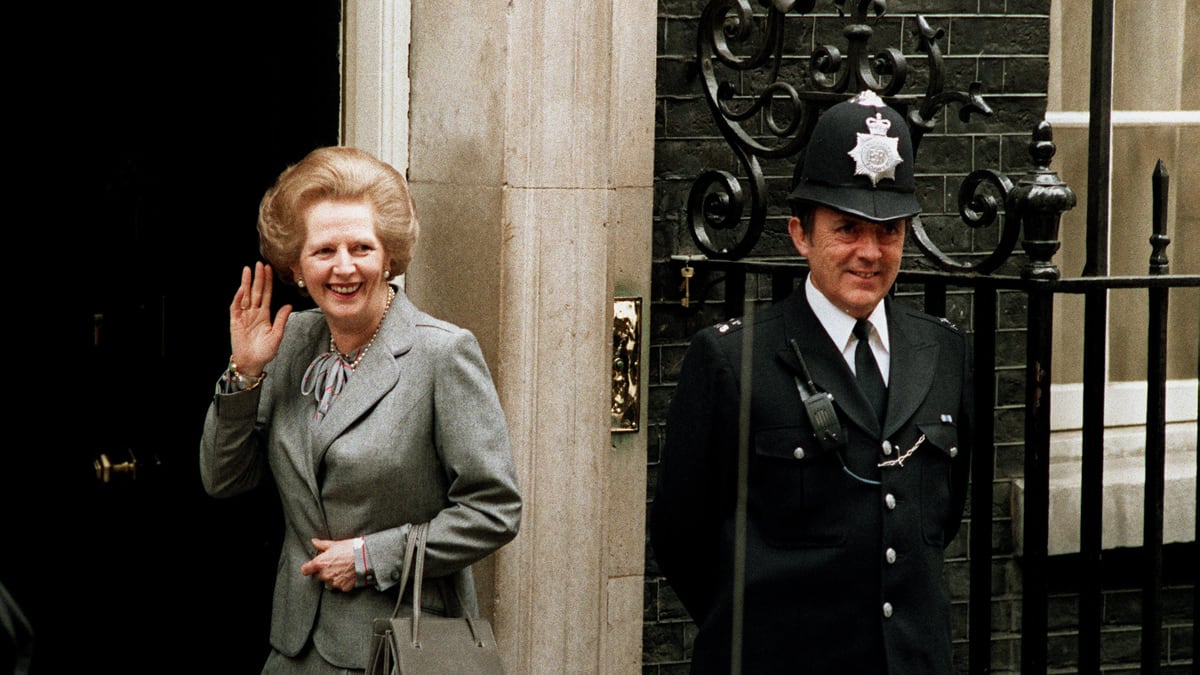It is not surprising that a handbag should figure so prominently in the film chronicling Margaret Thatcher’s legacy–a sprawling tale brought to the big screen by Meryl Streep in The Iron Lady. This personal carry-all has long been both functional and symbolic. Depending on its style and brand, it can be a statement of status or a pronouncement of folksiness. Hand it off to a hen-pecked husband or a put-upon assistant and it can demean or belittle. A purse can impress and intimidate, bewilder, berate, or amuse.
During Thatcher’s tenure as prime minister of the United Kingdom from 1979 to 1990, her handbags came to signify femininity and toughness. Their style was unassuming: slender, structured, solid, and ladylike. They looked perfectly at home with Thatcher’s dignified suits and oh-so-British hats.
But those bags instilled fear in colleagues and combatants alike. What was lurking inside them? What might she pull out: incriminating papers, devastating notes, embarrassing memorabilia? For men, the handbag is a vast, vaguely terrifying mystery. What personal unmentionables lie within?
Her pocketbooks came to be viewed as veritable munitions depots constructed of polished black leather. They became a synecdoche for the woman herself: conservative, intimidating, feminine. (An Asprey bag that belonged to her sold this summer at auction for about $39,000.)
Thatcher didn’t need to wield a gavel. She could place her bag on the table to announce her presence. This swaggering announcement of womanhood was a way to consume space and demand attention. It marked her territory. To be sideswiped by Thatcher was to be “handbagged.”
The fashion industry has long known that women–even those who shun clothing fads and have little interest in navigating life in impractical shoes–share a certain illogical passion for handbags. They can be a source of pure delight for women who lead oppressively serious lives. Handbags can be security blankets for the most powerful women–held close even when they could be palmed off on a chorus of aides. Pocketbooks can signify a common touch among the most rarified. And the “right” bag can make a woman of humble beginnings feel as though she has achieved a level of success.
Queen Elizabeth II regularly carries a handbag although she clearly does not need to carry keys, cash, or identification. Reports have suggested that she keeps lucky charms, family pictures and a makeup case in her handbag. But more than what’s in it, the mere presence of it both unnerves and fascinates.
It’s such a gesture of normalcy by a woman whose entire life has been an anomaly. Perhaps it makes her feel a bit more “real,” more like an average woman who might joke about the forgotten items lurking in its seemingly bottomless pit? The pocketbook is where the Queen keeps her “stuff”–the things she obsessively believes she needs to be prepared for the day, for the unexpected, for life.
First Lady Michelle Obama can often be seen with a handbag. A blue Reed Krakoff tote is a favorite. What could a first lady–with Secret Service only a few steps behind–possibly need to keep so close? (A lipstick? First ladies don’t put on lipstick in public.) The handbag is part of being regular–a way of staying real inside the bubble.
A handbag is pleasure. In an interview this year with Harper’s Bazaar, secretary of state Hillary Clinton—well-known for her ambivalence about fashion–admitted to a weakness for a good handbag. In particular, Clinton was enamored of her fuchsia Salvatore Ferragamo satchel. “How can you be unhappy if you pick up a big pink bag?” she asked.
For women who live their professional lives in environments dominated by men, in places where attire ranges from black suits to navy ones, a handbag is one of the few places where whimsy can be safely indulged. (Madeleine Albright found joy in brooches, but also put them to diplomatic use thanks to the not-so-subtle messages they could communicate.) There is no diplomatic missive in a hot pink handbag. But, dear citizens of the world, who wouldn’t prefer to deal with a happy madam Secretary instead of a grumpy one?
A handbag can connote power and status. Thanks in no small measure to the success of the Fendi baguette in the 1990s, the pleasure of handbags became inextricably linked to prestige. The “it” bag was born–a talisman of stylishness and a signifier of insider savvy. The “it” bag wasn’t just popular. It was vaguely unattainable. It was defined by its offensively high price, pretentious waiting lists and limited edition variations.
Where once the Hermes Birkin was merely an expensively crafted bag favored by a tiny klatch of well-to-do women, the 1990s transformed it into the ultimate big game. It was thrust into the public consciousness through a storyline in Sex and the City.
Named after the British actress Jane Birkin, the handbag has no garish logos. It isn’t even as distinctive as a Chanel handbag with its quilted body and chain link shoulder strap. It retains an insider’s status, in part because its opening price point is approximately $10,000 and because the production of them is so limited.
Martha Stewart carried a Birkin into a New York courthouse during her 2004 trial for conspiracy, obstruction of justice and securities fraud. For a woman who was accused of acting as though her fame and money had put her above the law, appearing before a jury with a handbag that can typically only be accessed via celebrity or wealth was a let-them-eat-cake public relations move.
The Birkin symbolizes influence. It signals that a woman has arrived at a certain place in her life: successful enough to reward herself in a lavish way, connected enough to have circumvented the bag’s famed waiting list, or pampered enough to have received it as a gift. None of those things are the ideal message to telegraph to women on a jury.
Bags are a siren call for women. Unlike a cleavage-baring dress, a prim skirt suit, a pair of vertiginous stilettos, or fancy jewelry, the handbag delivers a message in a particularly female vernacular. What can be a monologue about class and social-climbing to women can be near gibberish to men.
Before reporter Judith Miller headed to jail–for her refusal to reveal a source–she walked in front of the cameras carrying an aggressively non-descript bag. Women know those bags, purchased because they are large or inexpensive or sturdy. No one likes them. They are too dull to elicit any sort of emotional response. But they are practical. And if there was any message that Miller wanted to deliver, it’s that she was the egoless reporter. She was taking a hit for the team.
About the same time, the rapper Lil’ Kim did a courthouse promenade carrying a $3,200 Louis Vuitton Le Fabuleux bag. She might have been going down for perjury, but she was still fabulous.
No one needs to be physically struck by a bag–in the manner of some octogenarian beating off a mugger–to know that it can be a powerful weapon. In The Devil Wears Prada, Meryl Streep’s character, an imperious fashion editor, flings her handbag onto the desk of her most junior, most put-upon assistant. The array of designer bags land like crushing blows to the young career girl’s self-esteem. She has been reduced to porter, to Sherpa, to something even less–some inanimate bit of set decoration.
The tossed off bag calls to mind the image of a sad sack, ignored husband uncomfortably holding his wife’s handbag as she nimbly navigates a department store or a cocktail party.
Anna Wintour, the editor of Vogue, moves through her professional life without a handbag–even as she reigns over an industry that is fueled by their sale. She once explained her dislike for handbags to the Wall Street Journal, noting that “Handbags weigh you down.” She carries a small notebook, a bit of cash and a cell phone. There’s power in her surprising refusal.
Thatcher’s power was in startling acceptance. She navigated all the stereotypes about femininity, class and tradition, turning them to her benefit. And on her journey, her stern, little black pocketbooks were a perfect accessory.






